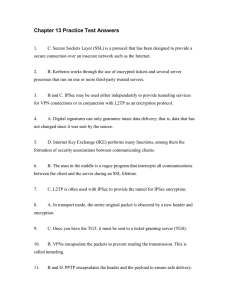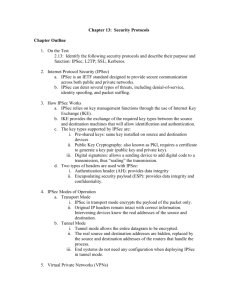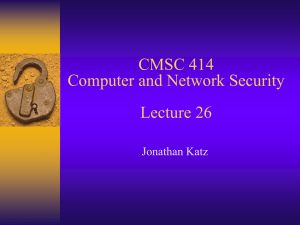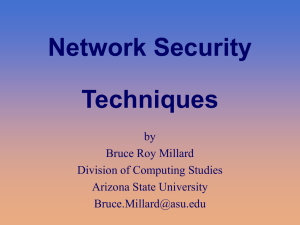SYSTEM ADMINISTRATION Chapter 13 Security Protocols
advertisement
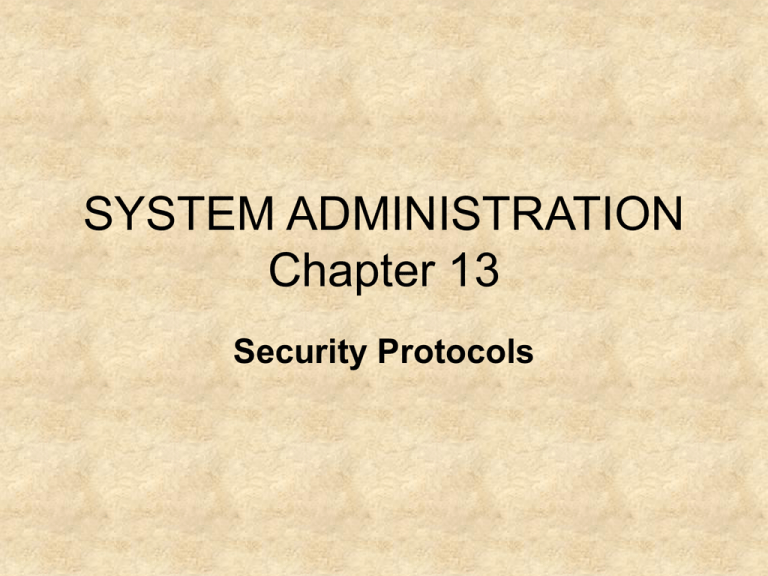
SYSTEM ADMINISTRATION Chapter 13 Security Protocols Internet Protocol Security (IPSec) • IPSec is an IETF standard designed to provide secure communications across both public and private networks. • IPSec can deter several types of threats, including denial-of-service, identity spoofing, and packet sniffing. How IPSec Works • IPSec relies on key management functions through the use of Internet Key Exchange (IKE). • IKE provides the exchange of the required key types between the source and destination machines that will allow identification and authentication. • The key types supported by IPSec are: o Pre-shared Keys – same key installed on source and destination devices. o Public Key Cryptography – also known as PKI, requires a certificate to generate a key pair (public key and private key). (continued) How IPSec Works (continued) o Digital Signatures –allows a sending device to add digital code to a transmission, thus “sealing” the transmission. • Two types of headers are used with IPSec: o Authentication header (AH) – provides data integrity. o Encapsulating security payload (ESP) – provides data integrity and confidentiality. IPSec Modes of Operation • Transport Mode – IPSec in transport mode encrypts the payload of the packet only. – Original IP headers remain intact with correct information. Intervening devices know the real addresses of the source and destination. • Tunnel Model – Tunnel mode allows the entire datagram to be encrypted. – The real source and destination addresses are hidden, replaced by the source and destination addresses of the routers that handle the process. – End-systems do not need any configuration when deploying IPSec in tunnel mode. Virtual Private Networks (VPNs) • The VPN is a transmission between two systems that makes use of the public infrastructure as the medium for transmission, extending the boundary of the private network. • VPNs rely on tunneling to create a safe transmission. • The tunneling protocol “wraps’ the packet (often just the header), creating a virtual tunnel through which the data can be transmitted. • The encapsulation provides the needed routing information. (continued) Virtual Private Networks (VPNs) (continued) • VPN transmissions usually contain an encrypted payload. • The advantages of VPNs include: o Safety of transmission o Flexibility in the business environment o Lower transmission costs o Lower administrative overhead Point-to-Point Tunneling Protocol • PPTP is built on PPP used for remote access connections. • Transmissions are subject to setup negotiation, authentication, and error-checking. • PPTP supports a multiprotocol environment, using IP as the transport protocol, but allowing other protocols (IPX, NetBEUI) to be used for communication on the remote network. • PPTP uses MPPE as its encryption protocol on Microsoft networks. • PPTP supports 40-bit, 56-bit, and 128-bit encryption schemes. Layer 2 Tunneling Protocol (L2TP) • L2TP is a relatively new tunneling protocol, built by combining Microsoft’s PPTP and Cisco’s L2F technology. • L2TP uses a five-step process for encapsulation. Deploying L2TP and IPSec • L2TP and IPSec are used together on Microsoft networks to provide secure communications over the Internet or intranet. • When combined, L2TP provides the tunnel and IPSec provides the payload encryption necessary for security. • To communicate using L2TP/IPSec, both the source and destination devices must understand the mechanisms and be configured to use them. Secure Sockets Layer (SSL) • • • Secure Sockets Layer (SSL) is a protocol that has been designed to provide a secure connection over an insecure network, such as the Internet. SSL runs above the TCP/IP protocol and below some of the higher-level protocols such as Hypertext Transfer Protocol (HTTP) and File Transfer Protocol (FTP). SSL uses a series of keys, public and private, to encrypt the data that is transported across the secure connection. (continued) Secure Sockets Layer (SSL) (continued) • • • The RSA algorithm, or cipher, is a commonly used encryption and authentication algorithm that includes the use of a digital certificate. The public key is made available to whomever needs it, while the private key is stored in a central location and never made public. Data that is encrypted with the public key can be decrypted only with the private key. SSL Server Authentication • SSL server authentication allows a client computer to identify the server that it is talking with. • A client using SSL-enabled software uses a public key to verify that the server’s certificate and public ID are correct and valid and that they have been issued by a certificate authority (CA) that is listed on the client’s list of trusted CAs. SSL Client Authentication • SSL client authentication is used to verify the client’s identity. • SSL-enabled server software checks the client’s certificate and public ID to ensure they are correct and valid and that they have been issued by a CA listed on the server’s list of trusted CAs. Encrypted SSL Connection • The encrypted SSL connection ensures that all of the information transferred between the SSLenabled client and SSL-enabled server are encrypted and decrypted during transmission. • Also, all of the data transmitted across the connection contains a mechanism to detect tampering, so the data can be checked to see if it was altered during the transfer process. SSL Subprotocols • The SSL Handshake Protocol – An SSL session begins with the SSL handshake process. – The handshake process is an exchange of messages that the server uses to authenticate itself to the client using a public key. – The client and the server cooperate to create symmetric keys that will be used for the encryption, decryption, and tamper-detection processes that occur during data transmission. – If necessary, the handshake process will also allow the client to authenticate itself to the server. • The SSL Record Protocol – The SSL Record protocol is used to define the message format that is used to transmit encrypted data. – The record protocol uses a series of algorithms that are generated by the handshaking process to encrypt the transmitted data. Man-in-the-Middle Attack • The Man in the Middle is a rogue program that intercepts all communication between the client and a server during an SSL session. Kerberos • Kerberos is a secure system, using strong encryption processes that are designed to provide authentication for users and services that need to communicate and be validated on a network. • Kerberos provides a way to prove identity in order to gain access to other network resources. • Kerberos works through the use of encrypted tickets and server processes that run on one or more thirdparty trusted servers. • The principals and the Kerberos server all share a secret password. • This secret password is used to verify that messages are authentic. Understanding the Kerberos Process • Begin the process by requesting authentication from the third-party, trusted Kerberos server. • This authentication server (AS) will create a session key, or “ticket-granting ticket” (TGT). • TGT goes to a ticket-granting server (TGS). • TGS verifies the ticket time stamps it and returns it to the principal that submitted it. • Ticket can be sent to accessible service. • Service can accept or reject the ticket. • Since the ticket was time stamped by the TGS, it is valid for more than one session. • Kerberos is the default encryption and security system used with Microsoft Windows 2000 operating systems.
